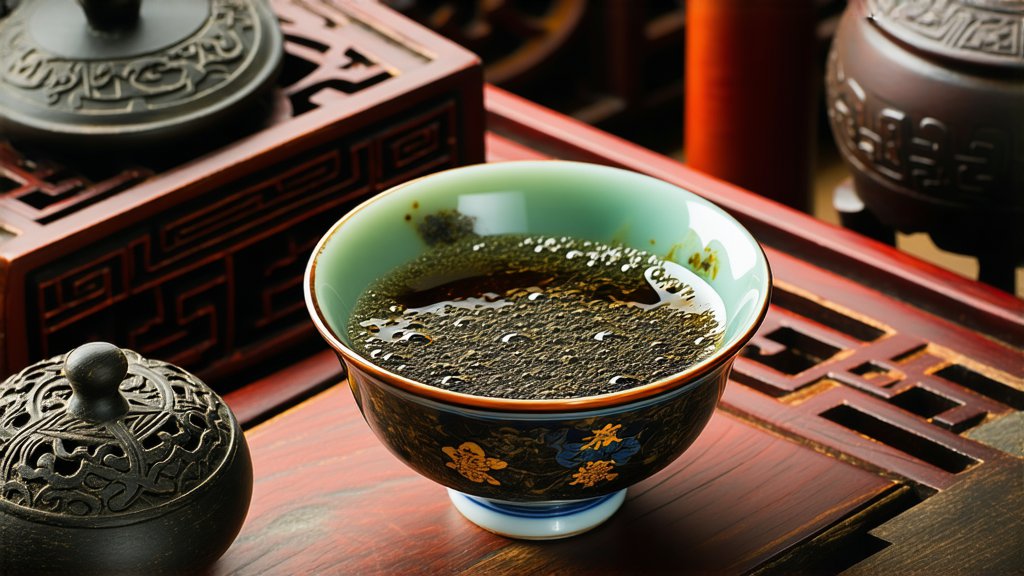
Pu-erh tea, a dark gem nestled within the diverse world of Chinese teas, stands as a testament to the rich cultural heritage and profound understanding of tea cultivation that has flourished in the Yunnan Province for centuries. This unique variety of post-fermented tea is not merely a beverage but a living entity, evolving over time and imparting its wisdom through every infusion. In this exploration, we delve into the historical roots, varieties, meticulous production process, and the art of appreciating Pu-erh tea, offering an invitation to international readers to embark on a sensory journey through one of China's most enigmatic tea treasures.
Historical Roots: A Legacy Woven in Time
The origins of Pu-erh tea trace back to the ancient caravan routes known as the Tea Horse Road, which connected Yunnan Province with Tibet and other regions. Legend has it that during the Tang Dynasty (618-907 AD), tea from this region was transported on horseback to various destinations, where it gained popularity for its unique taste and medicinal properties. Over time, the process of fermentation, essential to Pu-erh's character, evolved, leading to the development of what we now recognize as this distinctive tea. Its name, "Pu-erh," is derived from the market town of Pu'er in Yunnan, where tea was traded and aged, further enriching its flavor profile.
Varieties: A Spectrum of Flavors and Aging
Pu-erh tea comes in two primary forms: Raw (Sheng) and Ripe (Shou). Each variety offers a distinct experience, reflecting different stages of maturity and flavor transformation.
-
Raw Pu-erh (Sheng): Harvested from young tea leaves and sun-dried without artificial fermentation, Sheng pu-erh is known for its vibrant green color and brisk, astringent taste when young. As it ages, it undergoes natural fermentation due to microbial activity, gradually mellowing into a complex brew with earthy, fruity, and sometimes even floral notes. The aging process can span decades, with each year adding depth and character to the tea.
-
Ripe Pu-erh (Shou): In contrast, Shou pu-erh undergoes a controlled fermentation process called 'wet piling,' where heaps of tea are moistened and piled together to accelerate microbial growth. This method mimics the natural aging process but within a shorter timeframe. The result is a mature-tasting tea from the outset, characterized by its deep reddish-brown hue and smooth, mellow flavor profile, often reminiscent of wood, earth, and subtle sweetness.
Crafting the Perfect Pu-erh: An Art of Precision
The production of Pu-erh tea is an intricate dance between nature and human ingenuity. Here’s a glimpse into the steps involved:
-
Plucking & Withering: Tea leaves are handpicked and then withered under the sun to reduce moisture content.
-
Fixation: The withered leaves are quickly fried or steamed to halt enzymatic oxidation, preserving their green color and fresh aroma.
-
Rolling: Leaves are rolled into tight spirals, enhancing extraction during brewing.
-
Sun Drying (for Sheng): For raw Pu-erh, the leaves are dried naturally under the sun, retaining their vitality for future aging.
-
Wet Piling (for Shou): Ripe Pu-erh undergoes wet piling, where leaves are stacked and turned regularly to ensure uniform fermentation.
-
Aging & Compression: Both Sheng and Shou Pu-erh may be aged loose or pressed into cakes, bricks, or other shapes, allowing them to mature gracefully over time.
The Art of Appreciating Pu-erh Tea
To truly appreciate Pu-erh tea, one must engage all senses in a ritualistic manner:
-
Preparation: Begin with clean, boiled water and a Yixing clay teapot or a Gaiwan, both traditionally favored for their ability to enhance the tea's flavors. Warm the vessel before adding the tea leaves.
-
Infusion: Use approximately 5 grams of tea per 100ml of water. Rinse the leaves briefly with hot water to awaken them, then discard this first infusion. Subsequent infusions should range from 10 seconds to several minutes, adjusting based on personal preference and the age of the tea.
-
Aroma & Color: Observe the evolving colors of the liquor, ranging from bright amber for young Sheng to deep red-brown for aged Shou. Inhale the aromatic bouquet released during each infusion, noting any changes in fragrance.
-
Tasting: Sip slowly, allowing the tea to coat your palate fully. Notice the initial taste, mid-palate flavors, and the lingering aftertaste. With each sip, try to discern the tea's complexity, including its astringency, sweetness, body, and potential medicinal qualities.
-
Multiple Infusions: Pu-erh tea is renowned for its longevity in brewing. Enjoy multiple infusions, each revealing new layers of flavor and character.
Health Benefits: A Cup Full of Wellness
Beyond its captivating taste, Pu-erh tea boasts numerous health benefits attributed to its unique fermentation process and rich antioxidant content. Studies suggest regular consumption may aid in weight management, improve digestion, regulate blood sugar levels, and support cardiovascular health. Additionally, its probiotic properties promote gut health, contributing to overall wellbeing.
In conclusion, Pu-erh tea embodies more than just a drink; it represents a cultural legacy, a testament to patience and craftsmanship, and a gateway to understanding the profound connection between nature and humanity. As you embark on your journey with this ancient elixir, may each cup serve as a reminder of the beauty found in slowing down, savoring the present moment, and appreciating the simple pleasures of life.